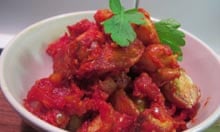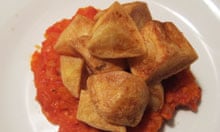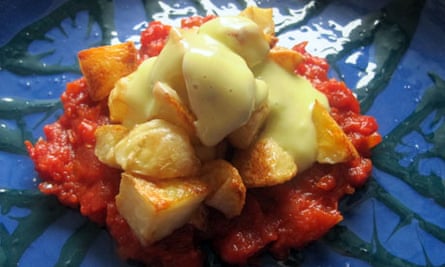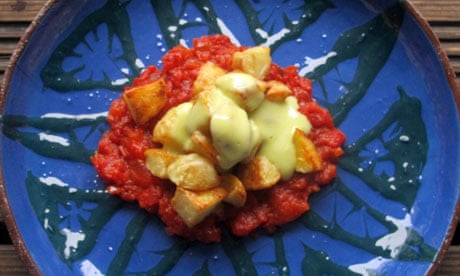I've never really got patatas bravas. Spuds in tomato sauce will never set my world on fire like crisp calamares fritos, or delicious morsels of morcilla, yet they're as inevitable an order in tapas bars as egg fried rice in a Chinese; just when you think you've got away with it, someone in the party always chips in – if you'll pardon the pun. Upon cross-examination, the guilty party will cite the superlative bravas they once enjoyed in a particular little bar in Logrono, or the incredibly clever interpretation of the dish in some Michelin-starred restaurant in Barcelona, blithely ignoring the fact that we're about 900 miles from either of those places on this particular evening.
However, given I seemed to be the only person in the world blind to the charms of these spicy spuds (Spain even has a social networking site named after them) it seemed possible that it was my experience of patatas bravas, rather than the dish itself, which was at fault. According to an article in the Wall Street Journal on the subject, patatas bravas is a real hot potato (sorry) amongst Spanish chefs because, although it's a simple dish, there are a million possibilities to explore within the basic formula of potatoes in a tomato sauce – "the potato will absorb whatever you give it," one Barcelona bar owner explained. Another restaurateur the paper spoke to claimed no one made patatas bravas at home: "They go to bars to try them. It is a social dish." All very well, when you live in Spain.
Traditional tapa
This fact is borne out by the fact that not one of my four Spanish cookery books makes mention of patatas bravas: I finally find one in The Book of Tapas, by Simone and Ines Ortega, authors of the classic Spanish collection, 1080 Recipes. Their recipe is apparently closest to a Valencian take on the dish, and the details come as a bit of a surprise: no tomatoes or frying required. I toss boiled, diced potatoes in a vinaigrette made from olive oil, white wine vinegar, hot paprika, chopped garlic, chilli powder and Worcestershire sauce (a condiment appreciated across the world, it seems) and the bravas are good to go. Except they're not bravas as I know it, just an – undeniably delicious – spicy potato salad.
British bravas

In search of something my British palate might recognise, I enlist the help of the distinctly un-Spanish Mary Cadogan, of Good Food magazine. Her recipe fits my idea of patatas bravas better – a spicy tomato sauce, made by sautéing chopped onion in olive oil until soft, and then adding a tin of tomatoes, some tomato puree, garlic, chilli powder, sugar and salt, and simmering the whole lot until pulpy.
The fact that she roasts, rather than fries her potato cubes, surprises me (although not as much as the boiled spuds in the Ortegas' recipe) but actually, thanks to the olive oil and hot oven, they come out deliciously crisp. Sadly this doesn't last once I toss them with the sauce, which is rather too jammy for my taste – although patatas bravas are not always as wild as they sound, I'd like a bit more spice here.
Pizarro's patatas

As a founding partner in Tapas Brindisa, the fabulous Borough Market bar where punters queue out the door for iberico ham croquetas and, yes, "fried potatoes with brava sauce", chef José Pizarro seems like he might have a good grasp on both authentic Spanish cooking, and British expectations. I track down a recipe online in which he insists that the "salsa has to be spicy and smoky, and the potatoes lovely and crisp". A man after my own heart.
To make his sauce, I sauté diced onion, leek, carrot and garlic in olive oil, and char a fresh red chilli on a hot griddle, and then add it to the pan, along with a tin of chopped tomatoes, and cook the whole lot for 20 minutes. While that's simmering away, I peel and cut my potatoes into 2cm cubes, and fry them at 140C for 10 minutes, then briefly again at 200C until crisp. The sauce is blended to a chunky salsa before serving, although following my experience with the last lot, I don't toss the two together. The potatoes are crisp, and I like the texture of the sauce, but it lacks the zingy punch I'm looking for: the bland potatoes need something more assertive.
The master

Asturian-born José Andès is the chef often credited with introducing the concept of tapas to the American public – and he's been richly rewarded; what higher accolade could there be than making avocado candy floss for Ellen DeGeneres? More interestingly for me, he's a man obsessed with patatas bravas, who claimed in a recent GQ interview to have spent the past 16 years tinkering with the recipe in an attempt to come up with the perfect dish. Which clearly I need to try.
I grate 6 fresh tomatoes into a bowl, and then push the flesh through a sieve to produce a tomato puree. (I'm worried about the quality of my Turkish tomatoes in March, but they smell reassuringly tomatoey.) I then simmer it with olive oil, sugar, sweet paprika, cayenne pepper and a bay leaf until reduced by two thirds, then add a little sherry vinegar and set aside.
I must then make a garlic sauce – because, it turns out, in many parts of Spain, patatas bravas demands a creamy garlicky sauce to balance out the spicy tomatoey one. I'm happy enough with this turn of events, given everything is better with garlic. Andrès' "modern allioli" is made by beating together olive oil, garlic, sherry vinegar and a whole egg using a hand blender.
The potatoes are twice fried in much the same way as Pizarro's, and then served on a bed of the spicy sauce, along with a dollop of allioli. I find the sauce itself too sweet, although the vinegar is a masterful addition, but the intensely garlicky allioli is a lovely foil to the tomatoey reduction, and serving the lot in this way means the potatoes remain crisp.
Perfect patatas bravas

To make my perfect patatas bravas, I've decided to roast my potatoes instead of frying them, which gives a less greasy, but equally crisp result (and is also considerably easier in most home kitchens) and make a sauce based loosely on Andrés' recipe, but with smoked paprika, rather than Josè Pizarro's chargrilled chilli, to add some depth, as well as a fresh chilli for heat.
The creamy, unashamedly garlicky allioli-style sauce completes the dish perfectly – the Spanish equivalent of my student kebab van favourite, chips with ketchup and garlic sauce. Paired with a chilled Spanish beer, I finally understand what all the fuss was about.
Serves 4-6
500g waxy potatoes
300ml olive oil
1 small onion, finely chopped
1 red chilli, finely chopped
400g tin chopped tomatoes
½ tsp sugar
½ tsp salt
1 tsp smoked paprika
2 tbsp sherry vinegar
1 egg
1 clove garlic, crushed
Chives, to serve
1. Preheat the oven to 200C. Peel the potatoes and cut into rough 2cm chunks. Put a roasting tray with 2 tbsp olive oil into the oven and leave to heat for 5 minutes, then take out, toss the potatoes in the hot oil, and bake for about 45 minutes until crisp and golden.
2. Meanwhile, make the sauces. Put 2 tbsp oil into a heavy-bottomed pan on a medium heat, and cook the onion for about seven minutes until golden and soft. Put in the chilli, and cook for another couple of minutes, then add the tomatoes, sugar, salt and smoked paprika and stir well. Bring to the boil, and then turn down the heat and simmer for about 20 minutes until thick and dark. Take off the heat, add 1 tbsp sherry vinegar, and adjust the seasoning if necessary.
3. To make the allioli, put the egg in the small bowl of a food processor along with the garlic and 1tbsp sherry vinegar. Add 1 tbsp olive oil and whizz until incorporated, then drizzle in the rest of the olive oil with the motor running, until you have creamy mayonnaise-style sauce. Season to taste. (You can also use a hand blender, but it's harder to drizzle and beat at the same time.)
4. Take the potatoes out of the oven and sprinkle with a little salt. Spread the tomato sauce on to the plates, put the potatoes on top, then add a dollop of allioli and a sprinkle of chives, and serve immediately.
Why is patatas bravas so popular, and where serves the best examples? Are there any other tapa dishes which lend themselves to home cooking?

Comments (…)
Sign in or create your Guardian account to join the discussion